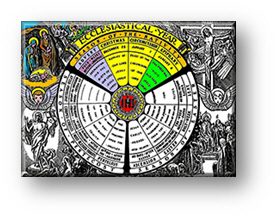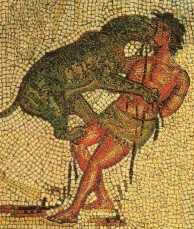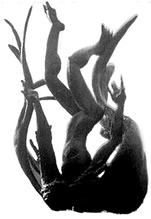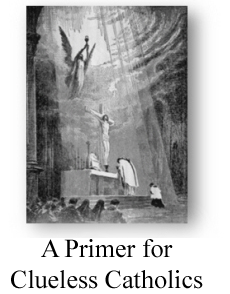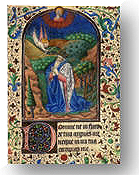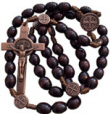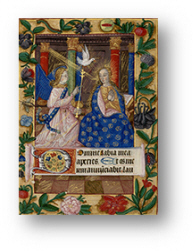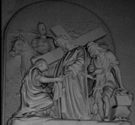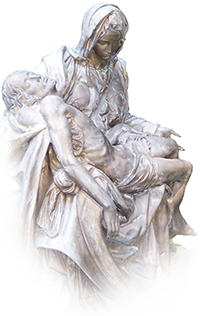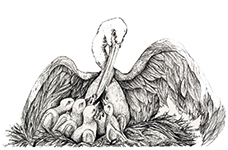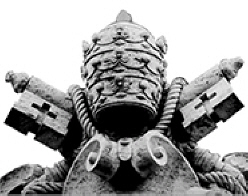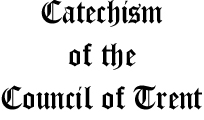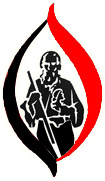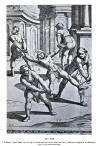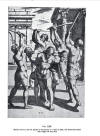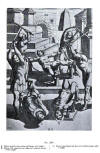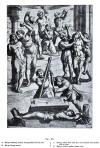|
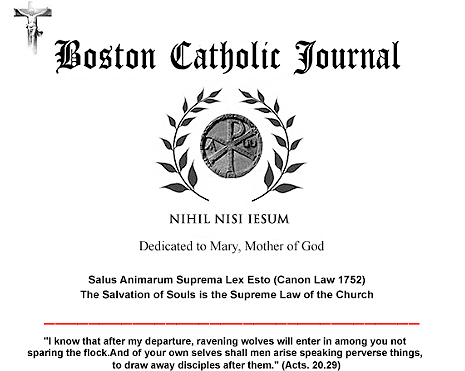
The Tortures and Torments
of the Christian Martyrs
from
De SS. Martyrum
Cruciatibus
(a Modern Edition)
Chapter IV
Of Different Instruments Employed for
Scourging the Blessed Martyrs
Having
discussed bonds and thongs and the nature of the “wooden horse,” we
must next turn our attention to the various kinds of whips and
scourges used in torturing the Martyrs. Indeed, after binding the Christians
to the “horse”, it was the frequent practice of the Heathen — as we
had seen in many instances already quoted from the History of the
Saints, especially those of St. Crescentianus, St. Regina, virgin
and martyr, and Bishop Bassus — to beat them mercilessly with rods,
cudgels, whips, and the like; then to flay them with iron “claws” or
similar devices; and finally to roast them with torches, burning brands,
and red-hot metal plates.
We will now discuss the
various instruments used for scourging in this order: first, whipping
instruments, then, iron hooks, claws, and currycombs;
and lastly, torches, brands, and fiery plates.
As to the first, which
were widely used in antiquity we find lashes, scourges, cudgels, rods,
scorpions, thongs, and loaded whips.
Of
Lashes
Plautus speaks of lashes
in the Epidicus, as follows:
Ita non omnes ex
cruciatu poterunt eximere Epidicum. Periphanem emere lora vidi ...
(“So all his friends shall not save Epidicus. I saw Periphanes
buying lashes.”)
Also Terence, in Adelphi:
Nam si molestus
pergis esse, jam intro abripiere, atque ibi. Usque ad necem operiere
loris.
(“For if you are going to be troublesome, you shall be rushed
indoors, and there lashed to death.”)
And Cicero, as well, in
his Philippics:
Cum eum jussu Antonii
in convivio servi publici loris caeciderunt. (“When the public
slaves scourged him with lashes at a feast by Antonius’ orders ...”)
Similar mention is found
repeatedly in the Acts of the Martyrs, as, for example, in the
account of St. Asterius and his companions in martyrdom, of St. Euphemia,
virgin and martyr, and many other witnesses of Christ of both sexes.
These lashes used by the ancients were thongs made of leather, usually
employed (as we have seen from the passages quoted from Plautus and
Terence) for the correction of slaves. It is no surprise, then, to find
consistent examples in the accounts of the martyrdom of Christ’s faithful
followers being beaten with thongs; for they were always counted by
the Heathen as wretches of the lowest condition. These same lashes served
not only to bind the martyrs and thrash them, but even
to tear them in pieces, as we witness in the Acts of the Blessed
Martyrs concerning the passion of St. Tyrsus:
“His mind (the
Governor’s) was suddenly filled with great wrath, and he ordered
certain stalwart young men of a fierce and savage disposition to
pummel the martyr with their fists. Then, after binding him with
lashes attached firmly to his hands and feet, they started strenuously
pulling in opposite directions, so that all the articulations of
his joints were broken, and he was torn limb from limb.“
Of
Thongs, Also Used for Scourging the Martyrs
The word “thong” or “nerve”
(as we explained in the preceding chapter) actually appears to have
had several meanings. Sometimes it simply signified a fastening for
binding criminals, as we had previously noted; but at other times it
appears to take the form of a scourge with which the Christians, fired
by love of the only true God, were beaten by the Heathen. It is in this
sense that we presently examine it. So understood, it appears to have
been an animal’s nerve that was used for the purpose; and most generally
a bull’s. This was the case with those most glorious athletes of Christ,
Saints Ananias, Isidore, Benedicta, virgin and martyr, and many others
whose names are written in the Book of Life.
Of
Cudgels and Scourges
Cudgels and scourges were
very often used for thrashing Christ’s faithful followers. Scourges
are spoken of by Juvenal in his Satires, Suetonius in his
Otho, St. Cyprian, Eusebius, and other ancient writers. They were
thinner and finer than cudgels, but thicker than rods. We find evidence
of this in the Laws of Theodosius (“Of driving on the public roads,
stage-drivers and couriers”) the following provision:
“Decreed, that no
man use a cudgel for driving, but either a rod, or at most a scourge
at the point of which is set a short goad.”
This is sufficient to
show that scourges were in use among the ancients as we stated above.
Besides Christians, other persons of the more humble class were condemned
to be thrashed with these instruments, as Plautus, in his Amphitryon,
implies; even the Vestal Virgins themselves, if by their neglect the
fire impiously consecrated to Vesta, the Roman’s false goddess, had
been allowed to go out (See Valerius Maximus and Livy the Historian).
However, to return to
the Blessed Martyrs of our Lord Jesus Christ, we find that many of them
were beaten with scourges and cudgels: with cudgels, Saints Felix and
Alexander, Privatus and Bassus, Bishops, Julius, a Senator, and many
others; and with scourges, the Blessed Martyrs Neophytus, Julianus,
Tryphon, Sabbatius, and countless others, whose names are forgotten.
Of these we find the following record in the Roman Martyrology
under February 20:
“Commemoration of
the Blessed Martyrs at Tyre in Phoenicia, the number of whom is
known only to God. Under the Emperor Diocletian and by order of
Veturius, master of the soldiers, they were slain with many kinds
of torments following one after the other. First, their whole bodies
were torn with scourges; then they were delivered to various kinds
of wild beasts but, by divine goodness, were in no way hurt by them.
Finally, given up cruelly to fire and sword, they won the crown
of martyrdom.”
Here it must be mentioned
that the Christians were sometimes beaten so long with cudgels and scourges
that they died under the lash. Thus perished those gallant soldiers
of Christ, Saints Sebastian; Julius, a Senator; Maxima, virgin and martyr;
Eusebius, Sabbatius, and many more of either sex.
Of
Cudgeling, Decimation, and other Military Punishments
We often read in the Histories
of the Saints how Christians, — especially Christian soldiers — were
ignominiously condemned to dig, beaten with cudgels and rods, stripped
of their military belts, and decimated — all of which were forms
of punishment for Roman soldiers guilty of various offenses.
Let us, then, examine
each of these penalties, some of which were less and some more severe.
While within the City walls, the Portian Law safeguarded Roman citizens
against the Magistrates’ rods and axes, this was not the case in camps
and in the field. Indeed, the Laws drew a distinction between military
and civil discipline, between the terror needful to bend an army to
obedience and that required to govern a peaceful people. From the orders
of a General in the field there was no appeal.
The lighter penalties inflicted on soldiers were of the nature of disgrace
and degradation only, such as:
-
being dismissed from
the service in ignominy
-
being fined or otherwise
having their pay diminished
-
relinquishing their
spears
-
change of their quarters
-
to winter in the open
country
-
to eat their rations
standing
-
to dig a trench
-
to be unbelted and
disarmed
-
to be fed on barley
-
and to be blooded
by opening a vein.
Graver punishments involved
causing bodily harm, such being beaten with rods, sold into slavery,
struck with a cudgel or an axe, to be decimated, or to be crucified.
We will find all these methods well documented in Sigonius, book 1,
On the Ancient Civil Law of the Romans.
First as to dismissal from the service with ignominy:
we find this mentioned and described by the Consul Aulus Hirtius in
the following terms:
“Caesar, speaking
from the suggestus (platform) and addressing the assembled
Tribunes and Centurions of all the Legions, said thus, ’Whereas,
Caius Avienus, in Italy you have stirred up Roman soldiers against
the Commonwealth, and have plundered the provincial towns, I hereby
expel you with ignominy from my army.”
As to deprivation
of pay, this is clear enough in itself, but I may add that the
phrase “broken in pay” was applied (so Nonius states) to those soldiers
whose pay, in order to brand them with disgrace, was stopped, that is
to say, the sum of money representing their gains for a month, or a
year, was confiscated. So Varro, quoted by the same author, speaking
of the life and habits of the Roman people, writes:
“What was known as
a soldier’s pay was the money given him half-yearly or yearly; when
his pay was stopped as a mark of disgrace, he was said to be
broken of his pay.” Livy again says: “As a mark of disgrace,
it was decreed this legion should receive a half-year’s pay in lieu
of a whole year’s.”
Now with regard to other
punishments, as that of surrendering the spear, Festus explains the
matter this way:
“Penalty of the spear
so called was when a soldier was sentenced by way of punishment
for a military offence to hand in his spears.”
As to changing quarters
in camp, Polybius tells us that if it was determined that soldiers
should be punished with disgrace, they were ordered to pitch outside
the camp. Accordingly in Livy, we find the men who had been beaten at
Cannee complaining:
“Now are we reduced
to a worse condition than returned prisoners of war had to suffer
in former days. For only their arms, and their position in the line
and the place where they might pitch in camp were changed, all which
they could recover by one good achievement for their country’s good
or one successful battle.”
As to winter quarters,
read Livy (book 26.):
“A further disgrace
was inflicted in every case, namely, that they should not winter
in a town, nor construct winter quarters within a distance of ten
miles of any city.“ As to rations, the same author
(book 24.) writes: “The names of all who withdrew from their post
during the previous defeat, I shall order to be reported to me,
and summoning each before me, shall bind one and all upon oath never,
except in case of sickness, to take food or drink otherwise than
standing, for as long as they shall remain in the service.”
As to digging,
we may appeal to Plutarch, who says in his Lucullus that it was
an old form of military disgrace for culprits to be compelled to strip
to their shirts and dig a trench, while the rest of the troops looked
on.
For the other penalties mentioned, see Livy again (book
27.):
“The cohorts which
had lost their standards, he ordered to be served with barley; and
the Centurions of those maniples [a Roman Army tactical formation]
whose standards had been lost, he unbelted and deprived of their
swords.“ Polybius also speaks of barley being served out instead
of wheat as a mark of disgrace.”
In the way of letting
blood as a punishment, the historian Aulus Gellius says the
following:
“This was another
old-fashioned military punishment, to order by way of ignominy:
a vein to be opened and the offender blooded.”
Concerning other
and more severe forms of punishment,
the following passages
from Livy provide clear evidence. Writing of Scipio’s reform of military
discipline before Numantia, Livy tells us that:
“Any soldier he caught
out of the ranks, he scourged — if he were a Roman citizen:
with staves, if a foreigner: with cudgels,“ and in another place,
“Publius Nasica and Decius Brutus, the two Consuls, held a review
of the troops, on which occasion a punishment was inflicted that
was likely to have an excellent effect on the minds of the recruits,
before whom it was carried out. A certain Caius Matienus, who had
been accused before the Tribunes of the People of desertion from
the army in Spain and condemned to the fork, or pillory, was beaten
with rods for a long time, and then sold into slavery for a sesterce.“
Also Cicero, in his Philippics: “The legions deserved cudgeling
which deserted the Consul, if he was Consul.”
Now, according to Polybius,
this punishment of cudgeling was inflicted in the following
way. First the Tribune took up a cudgel and just touched the condemned
man with it; after this, all who were in camp at the time were set upon
him, beating the culprit with cudgels, pelting him with stones, and
most often killing him inside the camp. Moreover, if any escaped, they
were no better off, since they could neither return to their fatherland,
nor be harbored at home by their relations.
The most ancient instance of decimation is recorded by
Livy and was carried out under his Consulship by Appius Claudius, a
man of a very stern and harsh disposition. To quote the Historian’s
words:
“Appius Claudius,
the Consul, called a general muster and rebuked the troops as disloyal
to military discipline and deserters from the colors — and not without
good reason. Turning to individual soldiers whom he saw unarmed,
he demanded where their standards and their weapons were, asking
a similar question of ensigns who had lost their colors, as well
as Centurions and double-pay men who had forsaken the ranks, and
finally had them beaten to death with rods. Of the remaining rank
and file, each tenth man was chosen out by lot for punishment.”
The mode of carrying out
such an order is detailed by the same author, who writes concerning
Scipio’s punishment of his mutinous army at Suero:
“Then was heard
the voice of the herald proclaiming the names of those condemned
in the council. These were now stripped and dragged forward, while
at the same moment all the paraphernalia of punishment were exhibited;
they were then lashed to a stake and beaten with rods or struck
down with an axe.”
Crucifixion
as a military punishment is also mentioned by Livy:
“Deserters to the
enemy were more severely dealt with than mere runaways. Those with
a Latin Name were beheaded, while Roman offenders were crucified.”
These, then, were the
different sorts of military punishments exercised in the Roman Army.
That these continued in use down to the very end of the Republican period,
is clear from Suetonius when he says of Augustus:
“Any cohorts which
had given ground, he decimated and fed the survivors on barley;
Centurions who had deserted their post and likewise Manipulars in
the same case he punished with death. For other offenses he inflicted
various ignominious penalties — such as to stand all day in front
of the Praetorium, or headquarters, in some instances wearing the
tunic only and stripped of their belts, others holding a ten-foot
pole or even carrying a sod of earth.”
Regarding Christian soldiers
who won the Crown of Martyrdom at the hands of the Heathen, it is to
be noted (as we find in their several Histories) how they were
sometimes condemned to dig the ground or else were decimated, very frequently
beaten with cudgels and rods, or stripped — that is, deprived of their
military belts.
As to Christian soldiers being condemned to dig the ground,
we find the following written in the History of St. Marcellus,
Pope, concerning them:
“At the date
when Maximianus returned from the parts of Africa to the City of
Rome, being eager to please Diocletian and further his design of
building Thermae, or Baths, to be called after his name,
he began, out of hatred towards the Christians, to constrain all
soldiers of that Faith, whether Romans or foreigners, to forced
labor, and in many places condemned them to quarry stone, while
others were condemned to dig sand.” [for the construction of the
thermae] The same may also be found recorded in the Acts
of St. Severa, a Roman Virgin.
Decimation
again is attested
by the Histories of those most Blessed Martyrs of Christ, St. Maurice
and his companions, where we find written, “Let the fatal lot give every
tenth man to death,” — and what else was decimation but so putting to
death every tenth soldier? The Roman Historian Tacitus, reports of this
practice as well:
“Every tenth man of
the disgraced cohort was chosen by lot and cudgeled to death,“ and
again, “Inasmuch as every tenth man of the beaten army is beaten
to death, even brave men are at times chosen out by the lot.”
The next punishment,
cudgeling, was virtually universal for all those martyred
Christian soldiers who found it an occasion of joy to be rid of this
poor, brief life for Christ’s sake.
However, it was not Christian soldiers alone who were beaten with cudgels,
but other faithful servants of Christ as well; for the Laws of the Romans
decreed that whoever professed themselves to be filled with God’s grace
should be beaten with cudgels as a penalty.
Finally, further testimony to this effect is to be found in the
Acts of St. Hesychius, of St. Marcellus a Centurion, of Saints
Eudoxius, Zeno, Macarius, and their companions, — one hundred and four
in number — and many, many others. This is especially true in the
Acts of St. Marcellus, just mentioned, where we see that the military
belt, so often mentioned, was nothing more nor less than the ordinary
soldier’s sword-belt, or rather baldric, for in this account we find
the following:
“In the city
of Tingitana, when Fortunatus was Procurator and Commander of the
Troops, the Emperor’s birthday came round. So when all were indulging
in festivities and offering sacrifices, one Marcellus, a Centurion
of the Legion of Trajan, deeming the rejoicings to be profane, threw
off his military belt before the standards of the legion which were
present, and testified with a loud voice, saying, “I am a soldier
of Jesus Christ, the King everlasting.” Likewise he cast away his
Centurion’s staff and his arms, further declaring, “From this day
forth I make an end of fighting for your Emperors ...” But the soldiers,
astounded to hear such words, seized him and reported the matter
to Astasianus Fortunatus, Commander of the Legion, who ordered him
to be put in prison.
Presently when the
feasting was ended, he took his seat at the council board and ordered
Marcellus the Centurion to be brought in; this being done, Astasianus
Fortunatus, the Commander, thus addressed him: “What was your intent
when, in defiance of military discipline, you ungirded your belt
and threw away your baldric and staff? ” Then some lines lower down,
“This soldier, in casting off his military belt, has openly proclaimed
himself to be a Christian, and publicly before all the people spoke
many blasphemies against the gods and against Caesar. We now refer
this matter to you, that we may do as you see fit.”
These same words were
addressed by his jailers, concerning the Blessed Marcellus, to Agricolaus
the Judge, to whom he had subsequently been sent to be tried. Now when
we read at the beginning of this account how Marcellus cast away his
military belt; and again further on, how being charged before the Commander,
he casted away his baldric; and yet again, when the soldiers were stating
the case against him before Agricolaus, his belt once more — it is abundantly
clear that these were one and the same thing. In fact, a baldric,
if we may believe the authority of Varro, On the Latin Tongue,
was a belt of leather decorated with studs or bosses and worn aslant
from the right shoulder to the left hip. So Quintilian writes, “That
fold which is carried aslant from right shoulder across to the left
side, like a baldric, must be neither too chokingly tight nor yet too
loose.”
One point important to
observe is the constancy of Christian soldiers. It was unwavering; and
such was their burning desire to suffer for Christ’s sake, that there
is frequent mention of their having, voluntarily — and in contempt
and defiance of the heathen emperors and other great officers — cast
off the military belt. Thus we read of St. Hesychius:
“Now he was a soldier,
and having heard read the order of Maximianus to the effect that
any which should refuse to make sacrifice to idols, should lay down
his military belt, suddenly and of his own volition he unbuckled
his own.”
We find this again concerning
St. Eudoxius and his sainted companions:
“Eudoxius instantly
removed his girdle and tossed it in the Commander’s face. With this
act, seen by his comrades as a direct appeal to them and a call
to emulation, the whole number of them that stood around, one hundred
and four in all, likewise hurled their belts in his face.”
Of
Rods and Scorpions
Frequent mention is made
of rods with which prisoners were beaten. We find reference to them
in different plays of Plautus, by Valerius Maximus, by Cicero, and by
Prudentius in the Hymn of St. Romanus.
Rods in antiquity were of many sorts — some of elm-wood, as Plautus
says in the Asinaria:
Ipsos, qui tibi
subvectabant rure huc virgas ulmeas ... (“The very fellows that
used to bring you your supply of elm-rods from the country.”)
And a little further on
in the same play:
Mihi tibique interminatus
est, nos futuros ulmeos.
(“He threatened you and me; we should presently feel the elm.”)
Thus Plautus shows us
that people in antiquity routinely corrected their slaves with these
rods of elm-wood.
Others again, were made of birch, a tree which Pliny describes as:
“This Gallic tree
(the birch, to wit) is of a remarkable glossiness and slenderness,
a terrible material for the rods used by magistrates. Its flexibility
makes it equally convenient for hoops as well as for the plaited
work of baskets.“
Yet others again were
of oak, ash, or willow. Rods of the first sort are mentioned in the
Acts of St. Acatius, a Centurion, and of the third, willow, by
Prudentius in his Hymn of St. Romanus in these lines:
Cum puer torqueretur
jussu Praesidis,
Impacta quoties corpus attigerat salix,
Tenui rubebant sanguine uda vimina.
(“When the lad was tortured by the Governor’s orders, every
time the willow struck and wealed his body, the switches grew wet
and red with drops of blood”)
Moreover, in the Epidicus
of Plautus we find:
Lictores duo, duo
viminei fasces virgarum
(“Two apparitors and two bundles of willow rods and switches”).
Switches, in fact, were
made of poplar twigs, elm, red wood, birch, vine, twisted hazel, or
willow, the last being best for this purpose.
Of
Rods Made of Vine Wood
Rods made of vine wood
were used for beating military offenders; in fact, the Centurions’ sign
of office was a vine staff, which they used to chastise soldiers too
slow in obeying. This is shown in Pliny:
“The vine staff in
the Centurion’s hand is an excellent specific for bringing sluggish
troops to the colors, and when used to chastise offences makes even
the punishment respectable; ”
And Tacitus, as well:
“The Centurion Lucillus
was killed in a mutiny — an officer nicknamed in soldiers’ slang
’Give us another,’ because after breaking his staff over a soldier’s
back, he would loudly call for another, and then another.”
So too Juvenal ,writing
of Caius Marius in his Eighth Satire:
Nodosam post haec
frangebat vertice vitem,
Silentus pigra munires castra dolabra.
(“Then he would strike you over the head with a knotty staff,
if you were overly slow in entrenching and sluggish in your spade
work.”)
Of
Rods of Iron and Lead
Although rods for beating
offenders withal were generally made of thin twigs of trees, sometimes
they were made of iron or lead. This is shown in divers Acts
of the Blessed Martyrs, such as those of Saints Paul and Juliana, Saints
Christopher and Callinicus, among others.
Of
Prickly Rods, otherwise called Scorpions
Not with smooth rods alone
were those of antiquity accustomed to chastise offenders and Christians
as well, but also with knotty and prickly rods which they appropriately
named “scorpions.” Whenever we find record in the accounts of the martyrdom
of the saints — that such and such faithful servants of Christ were
beaten with thorny, prickly, and knotty rods — it is understood as their
having been scourged with “scorpions”.
Rods, then, were of two distinct types; they were either smooth or prickly.
If they are alluded to as of the first sort, smooth, they were either
of twigs or of metal. If of twigs, either of elm, birch, oak, ash, or
willow; but if of metal, then either of iron, and this sometimes red-hot,
or of lead.
Something more may be
added to what has already been said of rods in the Histories
of Saints Hermillus and Stratonicus, to this effect:
“Greatly angered at
these words, Licinus ordered Stratonicus to be stretched face upward
and thrashed on the stomach with rods of a three-cornered shape.
Now this was a grievous torture, scarcely tolerable by the human
frame, for the corners of these rods cruelly cut the flesh like
so many swords.”
Not only were the martyrs
named above — Saints Acatius, Paul, Christopher, Callinicus, Hermillus,
and Stratonicus — beaten with smooth rods, but many others as
well, including Saints Pontianus, Zeno, Theodore, Paula a virgin, Regina,
Claudius, and a vast number of others of either sex. But it was under
knotty and prickly rods, or scorpions, that those glorious soldiers
of Christ, Saints Basil, Cyrinus, Bassus a Bishop, Symphorian, Nicostratus,
Simplicius, and countless others, were mercilessly beaten.
Even while being beaten with rods was an extremely painful form of punishment,
intended to shame the individual as well, it was, notwithstanding,
a lighter penalty than some others. The ignominy associated with it
is clearly shown in various Roman laws such as the Porcian Law, the
Symphronian, etc., as well as from direct statements of ancient authorities,
such as found in Cicero’s Pro Rabirio and in
Verrem; it is also found in Josephus’ Jewish War, where it
is spoken of as something extraordinary that Caestius Florus scourged
Jews who enjoyed Roman citizenship with rods, and fastened them in the
criminals’ collar or pillory.
Even now, Catholics are often beaten with rods by the heretics of our
own time (1591). This is illustrated by Sanders, in The Anglican
Schism, where he says:
“Nor should this be
left unmentioned, that many of the common people, refusing to attend
the churches and profane services of the Protestants, and having
no money to pay the fine, are by the judge’s orders, long
and cruelly dragged through the city of Winchester, stripped naked,
and savagely beaten with rods.”
The manner in which this
is done is declared in the Theatre of Cruelties in these words:
“The Catholics were tied at the cart’s tail, and so whipped through
the streets.”
Of
Loaded Scourges, with which the Martyrs were Beaten
Loaded scourges — as the
Histories of the Blessed Martyrs indicate, to say nothing of
Prudentius, and certain paintings which can be seen here in Rome — were
a sort of whipping instrument made of cords or thongs, with little balls
of lead fastened to their end. They were liberally used to scourge the
loins, back, and neck of condemned persons. We find this mentioned in
many accounts of martyrdom, as well as by Prudentius, who writes
in his Hymn of St. Romanus:
Tundatus tergum
crebris ictibus
Plumboque cervix vertebrata extuberet:
Persona quaequae competenter plectitur,
Magnique refert, vilis sit, an nobilis.
(“Let his back be pounded with quick-falling blows, and his
neck scourged with lead till it swell up: each is appropriately
punished, and it makes no small difference whether he be a common
fellow or a noble.”)
The fact nevertheless
remains that it was customary in antiquity to punish only persons of
the more common sort with loaded scourges. The punishment was still
in vogue in the days of the Emperor Honorius, who beat the impious heresiarch
Jovinian and his vile associates with loaded whips, before finally banishing
them into exile.
While scourging with these loaded whips was not meant to kill criminals
— and it was actually forbidden by an enactment of the civil law to
beat a prisoner to death, — yet many nevertheless died under the blows
of these cruel instruments. This is clear from Ammianus Marcellinus
in an Epistle of Ambrosius, where he writes:
“What answer shall
I make afterward, if it be discovered that, on authority from me,
Christians have been killed, whether with the sword, with cudgels,
or with loaded whips?”
Among Christians who laid
down their lives for Christ under the loaded whip were: Sts. Maximus,
Papias, Severa a Roman virgin, with her brothers Marcus and Calendius,
also Sts. Gervasius, Januarius, Concordia, Privatus, Severus, Severianus,
and countless others, whose names we cannot possibly cover in this volume.
Many were the other faithful servants of Christ who were beaten with
loaded scourges without losing their lives. These were (to name a few
only) Saints Laurence, Artemius, Procopius, Gordian, Erasmus and Theodore
Bishops.
Of
Other Ways in which Lead was used for Torturing the Holy Martyrs
Lead was also used in
antiquity for torturing prisoners in two other ways. First, after stripping
them stark naked, they would pour it, in a boiling state, over their
bodies — a form of punishment that we will examine more carefully in
Chapter IX .
The other way in which
lead was used was neither for scourging nor burning, but for straining
and dislocating the several joints of persons condemned to this torture.
Arms being twisted backward and fastened above their heads, they then
had leaden weights hung upon their feet. Such leaden weights are referred
to by Ammianus, when he says, “Then are the leaden weights prepared.”
If the reader would like learn more about this form of torture, he should
explore the Histories of the Blessed Martyrs, St. Justus and
St. Mamans.
Of
the Manner in which Prisoners were Beaten in Antiquity
When prisoners were to
be scourged in the days of the early Martyrs, they were first stripped
of all clothing, and then whipped upon the back, stomach, or other part
of the body with rods or other instruments of flagellation. The apparitors
carried this out in many ways. Sometimes they would tie them to stakes
set upright in the ground, or to pillars; sometimes they would stretch
them on the earth, or else over sharp spikes a foot high and fixed in
the ground; at other times they suspended their victims aloft
with their bodies hanging straight down, or else mounted them on another’s
shoulders as boys do, and lashed their posteriors.
Another convenient
method was to fix four pegs in the ground, forcibly stretch their victims
out and, binding them hand and foot to these, kindling a fire underneath
them to make their torment more bitter still — all the while thrashing
them unmercifully. The magistrates of the Roman people always presided
at these tortures and would command their apparitors, or lictors
as they were called, first to strip their victims and lay them naked
either upon the ground or an instrument of torture as we find in most
of the Acts of the Holy Martyrs, especially those of Saints Ananias,
Secundianus, Clement of Ancyra, St. Barbara Virgin and Martyr, St. Apollinaris
Bishop, among others.
Further corroboration and more certain evidence of this may be gathered
from many writings of the classical authors themselves, in which we
find that the judges and magistrates of the Roman people would order
their officers to strip and punish criminals and to employ their rods
and axes upon them as they lay naked. Thus Livy writes:
“The Consuls
command the man to be stripped, and the axes made ready. “I appeal”,
cried Volero, “to the People; seeing how the Tribunes had rather
see a Roman citizen beaten with rods before their eyes than themselves
murdered in their beds by you. But the more furiously he shouted,
the more fierce was the lictor in tearing off his clothes
and stripping him naked.”
And in another place,
speaking of Papirius Cursor, Livy tells us:
“He bade the
lictor make ready his axe. At this command the Praenestine
stood astounded, but the other only said, ’Now to it, lictor,
and cut away yonder stump, which is a hindrance to the traffic.”
Also, Valerius Maximus,
relating the same story, says,
“He commanded the
rods to be got ready and the man to be stripped,”
Livy once more, in another
book of his History, writes:
“Then Papirius was
roused to fresh anger and ordered the Master of the Horse to be
stripped naked, and the rods and axes to be prepared.”
So likewise Cicero, in
his speech, In Verrem:
“Accordingly he commands
the man to be seized and stripped naked in the open forum and bound,
and the rods to be made ready.”
All these passages plainly
indicate that prisoners were beaten by the lictors only after
first being stripped of their clothing.
Now the fact that the Blessed Martyrs were whipped with lashes on the
back, stomach, or both, or on any other parts of their bodies, is found
very clearly in the Acts of the Martyrs Saints Clement of Ancyra
and Ananias, mentioned above, as well as of St. Claudius and his companions.
That they were beaten
in antiquity by the Heathen, after being tied up by the lictors
to stakes or pillars, stretched out on the ground, over sharp spikes
fixed in the earth, or else securely bound to four pegs, as described
above, can also be found many, many, Acts of the Blessed Martyrs,
such as those of Saints Paul and Juliana, Eulampius and Eulampia, brother
and sister, Saint Anastasia, a Roman virgin and martyr, and a host of
others. One may return again, in this connection, to what we had already
discussed in Chapter I concerning stakes, pillars and trees, to which
Christians were suspended to be tortured.
Lastly that the Holy Martyrs were beaten as boys are thrashed may be
learned from Prudentius’ Hymn of St. Romanus, where Asclepiades
gives orders concerning a boy Barula, whom all unwillingly and unwittingly
was about to be consecrated a Blessed Martyr to Christ:
“...pusionem praecipit
Sublime tollant, et manu pulsent nates.
Mox et remota vesta, virgis verberent,
Tenerumque duris ictibus tergum secent,
Plus unde lactis quam cruoris defluat.”
(“... He bids them lift the boy aloft and beat his buttocks
with their hands; then after stripping off his clothes, thrashing
him with rods, and rending his tender loins with heavy blows — from
which more milk may well flow than blood.”)
But it was not only boys,
like Vitus and Barula, that were thrashed in the manner of juveniles,
being mere lads, but others likewise older in age and of either sex
— a practice used, it would appear, in order to maximize the ignominy
and disgrace. Thus was St. Thomas, a most reverend Bishop, beaten —
as we find written in Victor, On the Vandal War — as was also
St. Afra.
Of
the Officers Whose Duty it was in Antiquity to Beat Prisoners
The officers charged with
the duty of beating prisoners by order of the Magistrates were called
Lictors. These officers were assigned to Consuls, Proconsuls,
and other Roman officials; Consul and Proconsul having twelve each,
other magistrates six, and the City Praetor only two. The lictors
walked before each magistrate, bearing bundles of rods tied up with
an axe in the midst, and known as fasces, so that whenever
ordered, they might unfasten it, and first thrashing the condemned man
with their rods, afterwards strike him down with the axe.
This can be readily confirmed
from many witnesses among ancient writers. To take Cicero first, he
says in his great speech, In Verres:
“Six stalwart lictors
stand round him, men well practiced in beating and thrashing criminals;”
And also Livy,
“Go, lictor,
bind him to the stake.”
The same, too, is proven
by the customary formula by which the lictor was commanded to
inflict this penalty on a traitor, which was:
“Go, lictor,
bind his hands; cover his head; hang him to the accursed tree.”
Thus Livy writes of the
Publius Horatius in the matter of the Horatii and Curiatii:
“So the Duumviri condemned
him to death; then one of them addressing Publius Horatius, said,
’I pronounce you, Publius Horatius, guilty of high treason. Go,
lictor, bind his hands’;“ and a little further on, “This
same man,’ he went on, ’whom you saw but now, Quirites, walking
honored, triumphant and victorious, can you bear to behold standing
beneath the gallows, bound and enduring lashes and torments? ’ And
when the eyes of the Albans could scarce endure so hideous a spectacle,
‘Go, lictor,’ he cried, ‘bind his hands — those hands which
so lately were armed and winning empire for the Roman People. Go,
cover the head of the liberator of this city; hang him to the accursed
tree; scourge him, either within the bounds, that is amid yonder
spears and spoils of the foe, or else without, that is, amid the
tombs of the Curiatii.’ ”
To complete our account,
we may add further what Aulus Gellius left on record concerning lictors:
“Moreover the lictors
had other duties to perform; it was their office not only to bind
and beat criminals and strike them with their axe, but also to hang
them, if need be; hence the words, ’Go, lictor, bind his
hands, cover his head, hang him to the accursed tree.’”
In addition to this, it
belonged to these same officers to clear people out of’ the road, on
occasion to silence those who spoke too much, and even to strangle criminals,
as Plutarch demonstrates in his Life of Cicero, writing of Lentulus:
“First the Consul
removed Lentulus from the Palatium, and marched him along the Sacred
Way and through the midst of the Forum. Then on leaving the Forum
and arriving at the jail, he handed his prisoner over to the
lictor, and ordered him to be strangled.”
Still another duty of
the lictors was to visit the houses of persons wanted in Court
and to strike on the doors with a rod to summon them. But enough
of lictors and their offices.
Of
Other Methods by Which the Martyrs were Struck and Beaten by the Heathen
Blows to the face, buffets,
and kicks were commonly inflicted on the Blessed Christian Martyrs.
Their faces were bruised with stones and their jaws broken, or they
themselves were overwhelmed by the stones and so done to death. These
afflictions were the fate of those most glorious heralds of our Faith:
Saints Marcellinus a priest, Epipodius, Aquilina, Tatiana, Felicitas,
Speusippus, Eleusippus, Meleusippus, and lastly Pothenus, or Pothinus,
Bishop of Lyons, whose death is described by Eusebius in his Ecclesiastical
History:
“Likewise the Sainted
Pothenus, to whom the Bishopric of Lugdunum (Lyons) had been entrusted.
He had now exceeded the ninetieth year of his age, and was so exhausted
with bodily weakness that he could scarcely breathe freely, so extreme
was his infirmity; yet his spirit was greatly refreshed and his
mind grown alert by the burning desire he had for martyrdom. So
he advanced boldly to the tribunal, and although his body was nearly
worn out by the decrepitude of advanced age and the tortures of
disease, yet was his soul preserved intact within him to triumph
gloriously in its steadfastness for Christ. Led by the soldiers
to the bar, the magistrates of the city going with him, and the
whole multitude of the people shouting insults at him as a Christian,
he exhibited a noble testimony to the Faith. For when he was asked
by the Presiding Judge who the God of the Christians was, he answered,
’If thou be worthy to know this thing, thou shalt know it.’ He was
immediately and roughly dragged from court and received many blows,
both from those who were standing nearby, who without respect for
his years, struck and kicked him shamefully and insultingly, and
likewise from others further away, who threw at him whatever each
had at hand. They did so because each and all would have deemed
it a great fault and an act of personal impiety had they failed
to punish him, believing that by so doing they were serving the
cause of their false gods. Finally, he was cast, barely breathing,
into the common jail, where two days later he died.”
Thus Eusebius writes concerning
the death of St. Pothenus. A similar end was suffered by the Blessed
Martyr, St. Fabius.
Of
Blows, Buffets, and Slaps
These three words are
held by some to be synonymous, but that this is not so is plainly shown
by many tokens. Thus in St. Matthew 26 we read:
“Then did they spit
in His face and buffet Him: and some smote Him with the palms of
their hands;”
And in St. Mark 14:
“And some began to spit
on Him, and to cover His face, and to buffet Him ... and the officers
received Him with blows of their hands;”
Likewise in St. John 18:
“ ... one of the officers
standing by struck Jesus with his hand.”
From these passages it
is plainly evident that the word buffet must be understood of
a slap struck with the palm or open hand, while a blow is one
inflicted with the clenched fist. This is further confirmed by the poet
Martial in his Epigrams:
O quam dignus eras
alapis, Mariane, Latini!
(“Oh! how well deserving you were, Marianus, of Latinus’ slaps!”);
And Terence in his play,
Adelphi:
Ne mora sit, si
innuerim, quin pugnus contintuo in mala haereat (“Not a moment’s
delay, when I give the sign; but batter his face instantly with
your fist”); and a little further on in the same play:
Homini misero plus quingentos colaphos infregit mihi (“Wretch
that I am, he struck me above five hundred blows with his fist”);
and again:
Omnes dentes labefecit mihi;
Praeterea colaphis tuber est totum caput.
(“He loosened all my teeth; besides which my head is all swollen
from his punches.”)
This distinction between
fist and palm, punch and slap, is well illustrated by a remark Cicero
makes in his treatise entitled The Orator:
“Doubling up his fingers
and making a fist, Zeno was used to say, ‘That’s what Dialectic
is like;’ then loosening his grip and opening his hand, he would
add, ‘But Eloquence resembles this open hand.’”
He said, in fact, the
Rhetorician or Orator was like the open hand; the Dialectician like
the fist, because while the former spoke at greater length, the latter
argued in a more compressed and forcible manner. Fisticuffs, or
punches, then, or blows are dealt with the clenched fist, buffets or
slaps with the open palm. But if the reader wishes further information
concerning this form of punishment and ignominy — by which women
in particular were punished for the Christian faith — let him read what
Aulus Gellius says on the subject.
Of
Martyrs Who had Their Faces Beaten with Stones, Features Bruised, or
their Jaws Broken
Among Christians who were
subjected to the above-named methods of martyrdom are Saints Papias,
Maurus, Theodosia, Felix a priest, Apollinaris a Bishop, Felicissima
virgin and martyr, beside the forty soldiers which be mentioned in the
Roman Martyrology under March 9:
“At Sebaste in Armenia,
anniversary of the forty sainted Cappadocian soldiers, who in the
days of Licinius and under the Governorship of Agricolaus, after
enduring bonds and cruel imprisonment, and after their faces had
been beaten with stones, were thrown into a frozen pond, where their
bodies, stiffened by the frost, were broken in sunder, and they
consummated their martyrdom by the fracture of their limbs. And
of these, two were of noble birth, Cyrion and Candidus by name.
The pre-eminent glory of them all has been renowned in the writings
of St. Basil and of others.”
Polybius, too, dealing
with military punishments, relates how in antiquity soldiers were not
only beaten with cudgels, but likewise stoned.
Of
Martyrs Who were Stoned, and so Gave Up their Lives
Among the Saints who were
stoned to death are numbered such renowned martrys as St. Stephen the
Proto-martyr, St. Demetrius and his companions, Saints Cyriacus, Tranquillinus,
Diocletius, and the most glorious Emerentiana and Paula, virgins and
martyrs.
Of
Great Stones Under which Christians were Pressed and Tormented
Moreover, the Christian
servants of Our Lord were tortured by means of great stones and rocks
in many different ways. Sometimes we read of their being crushed under
great boulders; thus in the Acts of the Blessed Martyr St. Theopompus
it is written:
“Hereupon the holy
man was led forth from his prison and stretched face upward on the
ground and bound fast to stakes; then a huge boulder, that eight
men could scarce carry, was laid upon his stomach. But the great
stone was lifted up from off him by the divine efficacy ...“
Again in the Acts
of the Martyr St. Victor we find:
“Being brought out
of prison after three days, with his foot he kicked over a
statue of Jupiter which was presented to him that he might offer
incense to it. The offending foot was instantly cut off, and the
holy man laid under a millstone, under which he was cruelly ground.
Amazingly, after a little while the mill broke in pieces of itself,
while yet the Martyr of the Lord was breathing faintly.”
And in the Acts
of the most Blessed Martyr, St. Artemius, we read:
“Hearing these words
and being filled with wrath, Julian called stonemasons to him and
said, ‘Do you see that block of stone?’, pointing to one that had
broken from the front of the Amphitheatre. ’Divide it for me into
two halves. Then, laying the one half flat on the earth, stretch
out this criminal upon it, and then let down the other half heavily
upon him, so that caught between the two he may have both flesh
and bones crushed out of all shape. By this means he shall learn
whom he is trying to resist and what help he may expect from his
God.’ No sooner said than done, the holy man was imprisoned between
the two stones, and so great was the weight pressing upon his body
that as his bones broke asunder, a sound of splitting and cracking
was actually heard by many. All his inwards were torn to pieces
and the articulations of his bones crushed while his eyes started
out of their sockets. Yet, even though he was reduced to such a
pitiable state, he did not neglect to sing to God’s praise; for
he chanted where he lay between the stones, saying, ‘Thou hast
exalted and brought me up, for Thou art my hope, and a tower of
strength in the face of mine enemy; Thou hast set my feet on a rock
and guided my steps aright. Receive therefore my spirit, Thou only
beloved Son of God, and deliver me not up into the hands of my foes!’
Finally, after he had remained a day and a night inside the stones,
the wicked Julian commanded the two blocks to be separated, thinking
that he had surely perished between them and that no vestige of
life was yet left him under so grievous and overwhelming a weight.
To Julian’s utter amazement, no sooner was Artemius freed of the
stones, than he came forth walking on his own feet — truly a miracle
worthy of all wonder and admiration! A man, naked and unprotected,
whose eyes had started out of his head, whose bones had been crushed
and all his limbs and flesh squeezed into one mass by the weight
of the stone, so that his bowels had miserably gushed out, this
man — O, strange and unexampled sight — was walking and talking,
and speaking words of rebuke against the tyrant, so that even he
was astounded.”
Another narrative of a
similar martyrdom by means of great stones is found in the History
of St. Joseph in the following words,
“Then after removing
the holy man to some little distance and binding his hands behind
him, they dug a pit for him and buried him up to the middle. Then
they set round about him the Christians they had arrested, and ordered
these to pelt and assail the noble victim with stones.”
But when, among the
rest, they urged the blessed and holy Isdandul to do this, she replied,
‘Never before in the world’s history was heard such a thing, that
a woman should be compelled to lift her hand against holy men, as
now you would have me do. It is not against your enemies you are
fighting, but against us, your friends, are you taking arms, and
filling with blood and carnage your native land, which was in peace
and quietness.’”
They then fastened
a spike to the end of a long reed and bade her prick the holy man
with it. But she cried again, ’Far be it from me to do this thing.
Rather would I drive it through my own heart than inflict the smallest
scratch on his sainted body.’ Thus did she manifest a manly constancy,
and showed herself stronger than those murderers had deemed possible.
“But now they proceeded to overwhelm the saint with such a storm
of stones that his head alone remained visible, all the rest of
him being buried beneath a heap of rocks. When one of the ruffians
saw the head still moving, he ordered one of the lictors
to take a stone as big as he could wield and throw it down on him.
When this was done and his head crushed by the weight of the stone,
the saint gave up his precious soul to Christ.”
Having examined the methods
of the torments of the Holy Martyrs in this fourth chapter, we proceed
next, with God’s blessing, to the fifth chapter.
CHAPTER V
Chapters:
1 -
2 -
3 -
4 -
5 -
6 -
7 -
8 -
9 -
10 -
11 -
12

Totally Faithful to the Sacred
Deposit of Faith entrusted to the Holy See in Rome
“Scio
opera tua ... quia modicum habes virtutem, et servasti verbum
Meum, nec non negasti Nomen Meum”
“I
know your works ... that you have but little power, and
yet you have kept My word, and have not denied My Name.”
(Apocalypse
3.8)
Copyright © 2004
- 2025 Boston Catholic Journal. All rights reserved. Unless
otherwise stated, permission is granted by the Boston Catholic
Journal for the copying and distribution of the articles
and audio files under the following conditions: No
additions, deletions, or changes are to be made to the text
or audio files in any way, and the copies may not be sold
for a profit. In the reproduction, in any format of any
image, graphic, text, or audio file, attribution must be
given to the Boston Catholic Journal.
|
|

